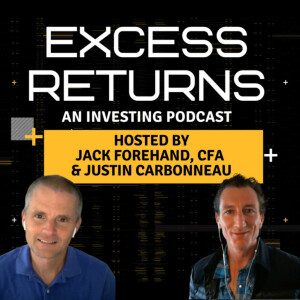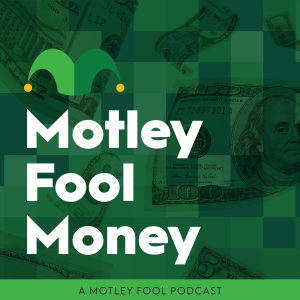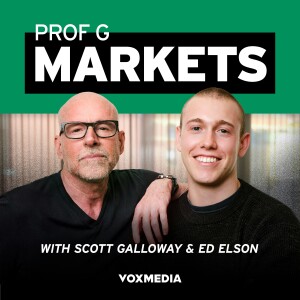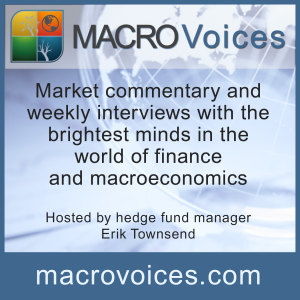

Excess Returns
https://anchor.fm:443/s/9a1dfac/podcast/rssEpisode List

Evidence Based Factor Investing | Matt Zenz
In this episode of Excess Returns, we sit down with Matt Zenz of Longview Research Partners to explore factor investing, evidence-based strategies, and the challenges and opportunities in today’s markets. Matt shares insights from his engineering background, his time at DFA, and his current work running the Longview Advantage ETF (EBI). We cover the nuances of value, momentum, size, implementation, and how investors can think more effectively about long-term returns.Topics covered:Matt’s journey from engineering to investingLessons learned at DFA and the foundation of evidence-based investingDefining factors and what makes them credibleThe role of value, momentum, quality, and size in portfoliosThe challenges of intangibles and redefining valueLarge cap tech dominance, mean reversion, and whether the world has changedFactor timing, valuation spreads, and Cliff Asness’ “sin” frameworkHow momentum can be integrated with value tiltsPortfolio construction: combining factors vs sleeve approachesImplementation challenges for large vs small managersHow Longview manages liquidity, turnover, and trading costsThe potential impact of AI on factor investingFuture opportunities in implementation alpha and ETF designMatt’s biggest investing belief most peers disagree withThe key lesson he would teach the average investorTimestamps:00:00 Value vs returns and factor investing basics03:00 From engineering and Boeing to investing06:15 Time at DFA and lessons in evidence-based investing07:30 What evidence-based investing really means09:25 Defining factors and what makes them valid12:00 Using value, profitability, size, and momentum16:00 Large cap tech dominance and future returns18:00 Mean reversion and whether the world has changed20:00 How long does value need to struggle before it’s “dead”?22:30 Should value be redefined for intangibles?25:30 Intangibles, R&D, and why adjustments add noise27:00 Value’s performance across economic cycles and migration30:00 Interest rates, growth, and value performance32:00 Factor timing and valuation spreads34:15 The role of momentum in timing and implementation35:00 How Longview applies passive-aggressive tilts36:30 Combining factors vs sleeve approaches39:00 How momentum is used in practice41:30 Factor migration and average holding periods43:00 The size premium and whether it still exists44:30 The benefits of being nimble vs large fund families47:30 Liquidity challenges in small cap value52:00 The role of AI in investing54:00 Where implementation adds the most alpha55:30 One belief Matt holds that peers may disagree with57:20 The one lesson for the average investor

A Volatility Masterclass | Timeless Lessons from 30 Year Options Trader Noel Smith
In this episode of Excess Returns, we’re joined by Noel Smith, co-founder and CIO of Convex Asset Management. Noel shares his unique journey from biochemistry and the military to market making, high-frequency trading, and running a volatility-focused hedge fund. We dig deep into volatility, regime models, income strategies, dispersion, tail hedging, and more, offering a rare look inside the world of professional options and volatility trading.Topics covered:Noel’s background: biochemistry, military, market making, HFT, hedge fund launchHow markets have evolved since the 1990sWhy volatility is the best source of market informationRegime shift modeling and its role in strategy selectionUsing options for income and the trade-offs investors should understandVolatility harvesting and risk-defined short vol strategiesThe impact of zero DTE options on marketsDispersion trading and correlation dynamicsBond vol arbitrage and volatility surfacesOpportunistic trades like GameStop and meme stocksTail hedging, its costs, and how to monetize hedgesLessons on flexibility, risk, and never being married to positionsTimestamps:00:00 Intro and Noel’s unique background06:00 How markets have changed behind the scenes07:00 Why volatility is the best information source09:00 Regime shift model explained19:00 Using options for income – benefits and risks24:30 Volatility harvesting strategies29:10 What the VIX does (and doesn’t) tell you30:30 Zero DTE options and systemic risk33:20 Dispersion trading explained42:00 Bond vol arbitrage45:00 Opportunistic trades: GameStop and beyond51:30 Tail hedging and rebalancing54:30 Lessons on flexibility and risk management

A Practical Guide to Market Valuation with Ben Carlson
In this episode, we sit down with Ben Carlson of Ritholtz Wealth Management and A Wealth of Common Sense to talk about market valuations, the rise of AI, investor behavior, and what history can teach us about investing today. Ben shares his perspective on why valuations are harder to use than ever, how market structure has shifted, and the lessons he’s learned as both a writer and an investor navigating major market cycles.Topics covered in this episode:Why market valuations are harder to use today than in the pastThe impact of buybacks, margins, and technology on long-term comparisonsMarket concentration and the dominance of mega-cap tech stocksPassive investing flows, investor behavior, and government backstopsHow AI compares to past technological innovations and its investment implicationsValue versus growth cycles and why U.S. tech has broken historical normsThe lessons of the NASDAQ since 2000 and defining the long term for investorsPersonal experiences from the 2008 financial crisis and the power of compoundingDiversification, gold’s surprising performance, and the case for international investingTimestamps:00:00 Introduction and market valuations06:00 Structural changes and the role of buybacks09:00 Margins, efficiency, and corporate dominance12:00 Market concentration and the rise of mega-cap tech14:00 Passive investing and household stock ownership18:00 Government backstops and market resilience23:00 Valuations as expectations vs. predictions25:00 AI boom and capital allocation29:00 Is this 1996 or 1999? Bubble comparisons32:00 How AI may reshape investing and daily life41:00 Investing in breakthrough technologies43:00 Value versus growth cycles in the U.S. and abroad46:00 Lessons from the NASDAQ and defining long-term investing49:00 Compounding lessons from the 2008 financial crisis53:00 Diversification, gold, and international performance

The New Valuation Regime | Jim Paulsen on Confidence, Inflation and the Coming Market Supports
In this episode, we sit down with Jim Paulsen to analyze the latest economic and market data through his lens of decades of market experience. Jim shares insights from his Paulsen Perspectives research, covering the job market, the Fed, inflation, valuations, investor confidence, and what they all mean for the future of the economy and markets. We explore why confidence is so low despite a bull market, how Fed policy is shaping market dynamics, and where investors might want to focus as the cycle evolves.Topics covered in the episode:The job market’s pivotal role in driving the economy and Fed decisionsWhy recent Fed rate cuts may mark a turning point in market support systemsThe narrowness of the bull market and how innovation-driven firms diverge from traditional cyclesInvestor confidence, the “misery index,” and recession probability modelsHow easing may broaden market participation beyond large-cap growthWhat “animal spirits” mean for small caps, high beta, and IPOsThe disconnect between inflation, bond yields, and growth measuresGold, cash, crypto, and tech as “fear assets” in today’s environmentThe impact of tariffs on profits, wages, and inflation expectationsValuations in context: historical perspective and the upward bias of multiplesTimestamps:00:00 Introduction and market overview02:00 Fed easing, inflation, and recession risks09:00 Bull market without normal supports17:00 Narrow leadership and innovative companies23:55 Confidence and the misery index29:35 Yield curve, recession probabilities, and Fed policy34:00 Broadening of market participation37:00 Animal spirit stocks and small caps38:00 Inflation, bond yields, and resource unemployment43:20 Copper-gold ratio and yields45:10 The role of gold in portfolios50:00 Cash, crypto, and tech as defensive assets54:00 Tariffs, inflation, and profit margins59:00 Inflation persistence vs. wage growth01:01:10 Valuations and the upward bias in multiples01:07:00 Closing thoughts and takeaways

Finding the Next Great Tech Compounders | John Tinsman
In this episode of Excess Returns, we sit down with John Tinsman, portfolio manager of the AOT Growth and Innovation ETF (AOTG). John shares how his investing journey began, the lessons he learned from both successes and failures, and how those experiences shaped his current investment philosophy. We dive deep into the concepts of low marginal cost, profitable growth, digital toll booths, and the transformative impact of AI. John also discusses his approach to valuation, position sizing, and why he believes large-cap growth and technology will continue to lead in the years ahead.Main topics covered:John’s path from personal investing to launching an ETFLessons learned from early stock picks and market-making experienceThe power of low marginal cost businesses and long-term compoundingHow AI is reshaping software development, innovation, and profitabilityThe importance of revenue and earnings growth in stock selectionDigital toll booths as the future of software business modelsDifferences between profitable vs. unprofitable growth companiesWhy technology leadership today differs from the dot-com eraThe role of sectors, valuation, and position sizing in portfolio constructionJohn’s views on growth vs. value, large-cap vs. small-cap, and future innovation trendsTimestamps:00:00 The riskiest thing in investing02:00 John’s background and early investing journey05:00 Lessons from Apple, Boeing, Visa, and Potash10:00 Insights from agriculture and value investing12:00 AI’s impact on software development and innovation16:00 Sectors, classifications, and thematic approaches18:00 Comparing AI disruption to past bubbles21:00 Profitability in today’s tech companies22:00 Will the top companies stay dominant?26:00 Large-cap vs. small-cap technology investing28:00 Growth vs. value in today’s market30:00 Demographics, Buffett’s lessons, and sector shifts34:00 Value vs. software companies35:00 Digital toll booths explained37:00 Growth sustainability and digital infrastructure40:00 Semiconductor cycles and long-term demand44:00 Screening for growth and low marginal cost47:00 Sell discipline and valuation checks49:00 Position sizing and portfolio management51:00 ETF tax benefits and structure53:00 Where AOTG fits in portfolios54:00 One belief peers disagree with56:00 One lesson for the average investor57:00 Closing thoughts and outro
Create Your Podcast In Minutes
- Full-featured podcast site
- Unlimited storage and bandwidth
- Comprehensive podcast stats
- Distribute to Apple Podcasts, Spotify, and more
- Make money with your podcast












